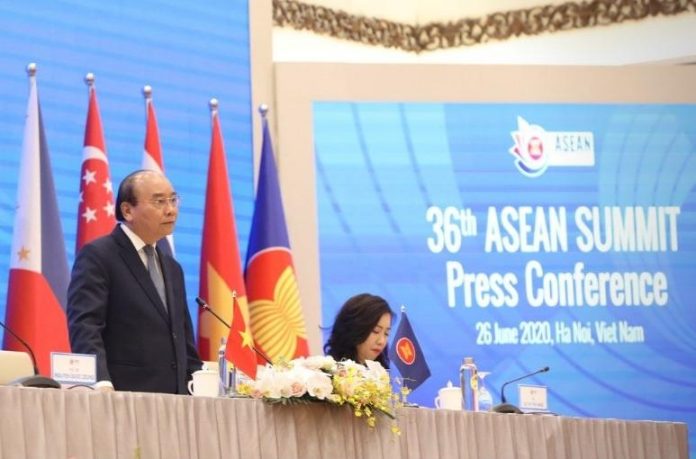The COVID-19 crisis has brought about many changes to the world, some are most apparent in those strategically important regions like Southeast Asia. As such, strategic diplomacy may be a good strategy for Southeast Asian countries to minimize the negative impacts of the crisis in the near future.
By definition, strategic diplomacy is “the process by which state and non-state actors socially construct and frame their view of the world; set their agendas; and communicate, contest and negotiate diverging core interests and goals”. Its primary task is to “adapt to the changing contours of the world order.” In respect to this definition, such a multi-pronged diplomatic strategy may be a good framework of actions for Southeast Asian states. Response to the COVID-19 pandemic entails a multilateral, holistic approach of governments in the region so that they can cope with the emerging new regional landscape more effectively.
At first glance, the COVID-19 outbreak has deteriorated the U.S.-China relations. Both sides have been actively taking part in a blame game, accusing each other of spreading the virus. Additionally, having gradually recovered from the pandemic, China has been taking advantage of the situation, ramping up its military presence in the South China Sea (SCS). The U.S. in response to China’s assertiveness, has expanded its naval force and joined the battle of diplomatic notes against China’s claims in the SCS. Their reciprocal actions have escalated the U.S.-China geostrategic competition which may lead to “a new Cold War”. Because of intensifying U.S.-China bilateral tensions, Southeast Asian states may have two most important strategic goals: avoiding becoming enmeshed in any sides’ sphere of influence, and constructing a favorable regional landscape.
Given these goals, strategic diplomacy could be instrumentally useful. As noted, it streamlines negotiation and order-building process. Based on ASEAN-led consultation and dialogue mechanisms, Southeast Asian countries could play a brokerage role to help China and the U.S. narrow their differences, which can help them to eschew choosing sides in the U.S.-China geostrategic competition. To a larger extent, they could advance the stable and harmonious rule-based regional order that is conducive to regional cooperation during the COVID-19 outbreak. Indeed, Southeast Asian states through ASEAN-initiated mechanisms, held special meetings with both the U.S. and China in order to respond to the crisis. Although these meetings have not yet produced desirable results of reducing the U.S.-China tensions and fully engaging them in the battle against the pandemic, they are illustrative of Southeast Asian countries’ efforts to play a stronger role in easing the U.S.-China straining relationship and constructing a stable, cooperative regional order.
Besides, the COVID-19 outbreak also undermines ASEAN’s role as a fulcrum of the regional web of institutions. There is a fragmentation among its members’ efforts against the pandemic in terms of policy efficaciousness. Countries like Vietnam or Singapore have contained the outbreak relatively well thanks to their timely response and rigorous quarantine measures, while countries like Indonesia or the Philippines have failed to do so.
ASEAN has established COVID-19 ad-hoc mechanisms, notably ASEAN-China Ad-Hoc Health Ministers Joint Task Force, Special ASEAN Summit on the COVID-19, ASEAN Business Advisory Council or Special ASEAN Plus Three Summit on COVID-19. Nonetheless, the policy cleavage as mentioned above illustrates that without ASEAN’s mechanisms, there are still countries coping well with the outbreak. Moreover, this also reflects the limited implementation of ASEAN-led initiatives. ASEAN has actively promoted multilateral, high-level discussions on preventing and controlling the pandemic. However, its approach to the COVID-19 outbreak remains superficial, leading to a high number of preventable cases and deaths in the region. Hence, there need for substantial improvement in ASEAN’s institutional capacity for combatting the pandemic.
In this respect, strategic diplomacy may be helpful for ASEAN as it seeks to synergize efforts of all actors. The pandemic has devastating effects on not only states but also non-state actors, such as businesses and NGOs. Therefore, it is imperative for all actors to make joint efforts to cushion the pandemic’s negative impacts on the region. As mentioned, strategic diplomacy takes all actors into account from state to non-state in setting the regional agenda. In this respect, if ASEAN was to adhere to the framework of strategic diplomacy, it could come up with a more concrete and effective COVID-19 strategy based on the interests of all actors in the region, regardless of state or non-state ones. With such an inclusive strategy in terms of stakeholders, ASEAN may be able to effectively deal with varied responses of its members, which thereby substantiates its unity and centrality in the midst the COVID-19 crisis.
Tectonic shift in the regional landscape necessitates that Southeast Asian countries pursue a holistic strategy to reinforce their power. Strategic diplomacy, thanks to its comprehensiveness and viable solutions to adapt to the changing landscape, is a reliable framework for Southeast Asian states. Effectively implementing this strategy, Southeast Asian countries might be able to survive well during the crisis and construct the new landscape in a meaningful way, paving the way for them to thrive on in the post-pandemic period.
Phuong Pham is a graduate student at School of Politics and International Relations, Queen Mary University of London. He has written for several online platforms, including East Asia Forum, Global-is-Asia and Asia and The Pacific Policy Society


